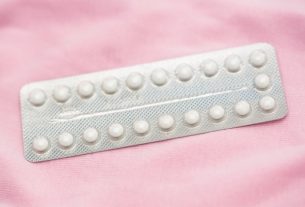The minipill is a contraceptive pill that contains only progestogen, in very low doses, and is generally recommended for women who are breastfeeding, as it does not alter the quantity and quality of breast milk.
In addition, the minipill can also be recommended for women who should not use estrogen-containing contraceptives, such as in cases of obesity, smoking, high blood pressure or high risk of cardiovascular disease.
Some brands of mini contraceptive pill that are sold in pharmacies are Cerazetti, Norestin, Micronor, Nactali, Juliet, for example. However, the minipill should only be used under the advice of a gynecologist.

When is it indicated
The minipill may be indicated in the following situations:
- Breast-feeding;
- Obesity;
- Smokers over 35 years old;
- Diabetes;
- High risk of heart disease;
- Endometrial and ovarian cancer.
Furthermore, the minipill does not increase the risk of venous thromboembolism and, therefore, may be recommended by a doctor for women with a history of deep vein thrombosis or pulmonary embolism.
How it works
The minipill works by interrupting menstruation, which prevents ovulation, altering the cervical mucus and movements in the uterine tube, making it difficult for sperm or egg to be transported.
The minipill is a contraceptive mainly recommended for breastfeeding women, as it complements the action of prolactin, a hormone that is produced during breastfeeding and has a small contraceptive effect. Discover other contraceptives recommended for breastfeeding women.
How to drink
How the minipill is used varies depending on the type of contraceptive and includes:
- Norethisterone minipill: it must be taken daily, at the same time and continuously;
- Desogestrel or drospirenone minipill: they must be taken every day at the same time for 24 consecutive days, followed by four placebo tablets.
In cases of mixed breastfeeding, starting to use the minipill may be recommended until the third or fourth week after birth. In cases of exclusive breastfeeding, the minipill can be used from the sixth week after birth.
Furthermore, during the first 7 days, the minipill must be used together with a barrier preventive method, such as a condom, to avoid unwanted pregnancy.
To find out how to use the minipill safely, make an appointment with the gynecologist closest to you:
Taking care of your health has never been easier!
Difference between birth control pill and minipill
The contraceptive pill is a medicine based on estrogen and progestogen hormones that inhibits ovulation, preventing pregnancy. However, this type of pill is not recommended for breastfeeding women, smokers over 35 years of age, those with high blood pressure, cardiovascular diseases, obesity, thrombophilia or venous thromboembolism.
The minipill also reduces the risk of pregnancy, however it can be used in cases of breastfeeding, obesity, diabetes, thrombophilia and thrombosis, or by women who smoke over 35 years of age, who have a high risk of heart disease or a history of thrombosis or embolism. pulmonary.
Possible side effects
Possible side effects with using the minipill are irregular periods, headache, acne, nausea, breast tenderness, slight weight gain, dizziness and mood changes.
Who shouldn’t use
The minipill is not recommended for women allergic to the components of the formula, in cases of pregnancy or suspected pregnancy.
The minipill is also not recommended for women with unexplained vaginal bleeding, breast cancer or severe liver cirrhosis.
Women who are taking anticonvulsants, antibiotics, St. John’s wort or antifungals should talk to their doctor before using the minipill. This is because these medicines reduce or cut the effectiveness of the contraceptive. Check out other remedies that reduce the effect of contraceptives.
Bibliography
- PORTUGUESE SOCIETY OF GYNECOLOGY. Contraception consensus. 2020. Available at: <https://www.spdc.pt/images/SPDC_Consensos_2020_novo_21julho2021_digital_book_website.pdf>. Accessed on 14 Nov 2023
- BRAZILIAN FEDERATION OF GYNECOLOGY AND OBSTETRICS ASSOCIATIONS. Progestogen-only oral contraceptives. 2022. Available at: <https://www.febrasgo.org.br/images/pec/vitamina-d/Anticoncepcionais-orais-contendo-somente-progestagnio-PT.pdf>. Accessed on 14 Nov 2023
- BRAZILIAN FEDERATION OF GYNECOLOGY AND OBSTETRICS ASSOCIATIONS. Frebrasgo Protocols: Contraceptive guidance in prenatal and postpartum periods. 2021. Available at: <https://sogirgs.org.br/area-do-associado/Orientacao-contraceptiva-no-pre-natal-e-no-puerperio-2021.pdf>. Accessed on 14 Nov 2023

Sign up for our newsletter and stay up to date with exclusive news
that can transform your routine!
Warning: Undefined array key "title" in /home/storelat/public_html/wp-content/plugins/link-whisper-premium/templates/frontend/related-posts.php on line 12
Warning: Undefined array key "title_tag" in /home/storelat/public_html/wp-content/plugins/link-whisper-premium/templates/frontend/related-posts.php on line 13



